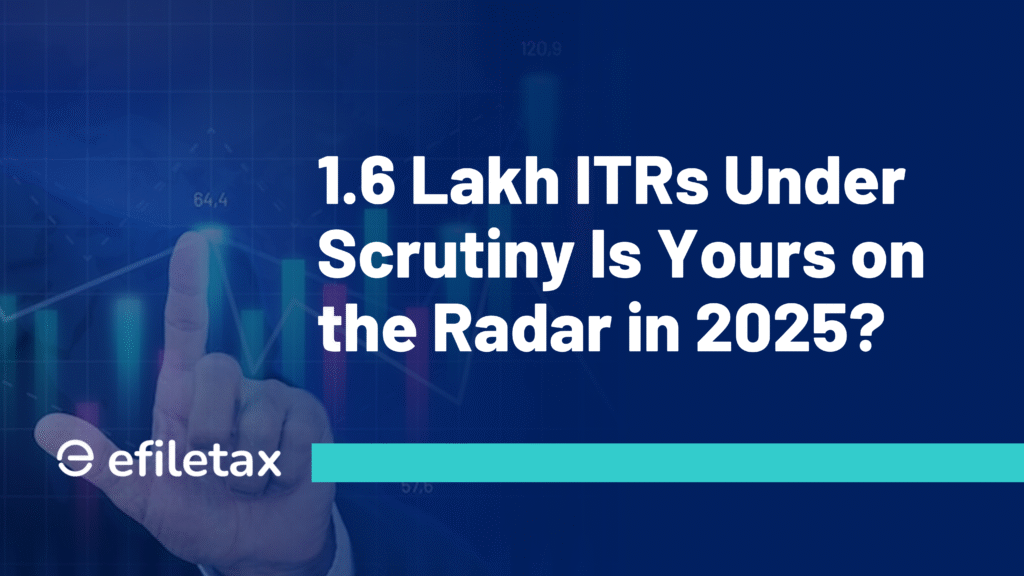
ITR Scrutiny Notices 2025 What Taxpayers Must Know
Over 1.6 lakh tax returns are under scrutiny this year as the Income Tax Department sharpens its focus on cash deposits, GST return mismatches, and mergers & acquisitions (M&A) discrepancies.
If you’ve received a scrutiny notice or want to avoid one, this guide simplifies what’s happening in 2025—and how to stay compliant.
Why Are Returns Being Scrutinised?
The Income Tax Department is using AI-powered data matching and PAN-linked integrations to detect discrepancies. According to CBDT insiders and official reports:
- Unexplained cash deposits during demonetisation-era assessments are still under lens
- Mismatch between GSTR-3B/1 vs. ITR filings is a red flag
- Incorrect reporting of capital gains or share swaps during mergers is a common issue
Key Red Flags for Scrutiny in AY 2024–25
Here’s what may trigger a scrutiny notice:
| Trigger Category | Common Issues Identified |
|---|---|
| Cash Transactions | High-value cash deposits not explained in ITR |
| GST Mismatches | Sales shown in GST > sales shown in ITR (esp. Sec 44AD/44ADA) |
| M&A Transactions | Not reporting capital gains on merger/split-up |
| TDS/TCS Mismatches | Credit claimed in ITR not matching Form 26AS / AIS |
| AIS/Traces Mismatch | Interest, dividends, crypto gains not disclosed |
📌 Expert Tip: Don’t ignore the Annual Information Statement (AIS). Cross-check it before filing your return.
What is a Scrutiny Notice?
Under Section 143(2) of the Income-tax Act, 1961, a scrutiny notice is issued if the department finds something inconsistent in your return. The new faceless system ensures it’s all digital and jurisdiction-free.
👉 The scrutiny process is now handled under the Faceless Assessment Scheme, making the system more transparent and reducing physical interaction.
What Should You Do If You Receive One?
Follow this step-by-step guide:
- Login to Income Tax Portal and check “e-Proceedings” tab
- Read the notice carefully – check under which section it’s issued (143(2), 142(1), etc.)
- Collect and submit supporting documents
- Respond online within the deadline (usually 15–30 days)
- Consult a tax expert or CA if the matter involves large sums or legal interpretations
🛡️ Efiletax Pro Tip: Always preserve bank statements, GST returns, and Form 26AS for the past 3–5 years.
Legal Backing and Government Sources
- Section 143(2) – Scrutiny of return
- CBDT Guidelines (2023 & 2024) for selection of scrutiny cases
- AIS & TIS Documentation on incometax.gov.in
- CBDT Circular No. 5/2024 – Use of data analytics and risk flags
Practical Insight
“Many small businesses under presumptive taxation (Sec 44AD/44ADA) get scrutiny notices when GST turnover exceeds declared income. Matching these numbers is key.”
— Tax Consultant at Efiletax
FAQs
Q1: What’s the difference between scrutiny and defective return notice?
A scrutiny notice (143(2)) reviews the content of your return. A defective return notice (139(9)) is about format or missing info.
Q2: Is scrutiny only for high-income taxpayers?
No. Even salaried individuals or freelancers can get picked if there’s data mismatch.
Q3: How long does a scrutiny case take to close?
Most faceless scrutiny cases are closed within 6–12 months, depending on response quality and complexity.
Summary
Over 1.6 lakh returns face ITR scrutiny in 2025. Focus areas include cash deposits, GST mismatches, and capital gains from M&A. Taxpayers should reconcile AIS, GSTR, and ITR data to avoid notices and respond swiftly to queries under Section 143(2).
Final Thoughts
Scrutiny is not a penalty—but a verification. With AI-based systems now flagging even minor errors, accurate and consistent filing is more important than ever.